What is it like traveling as a solo, blonde woman, for 20 days to a Muslim country in West Africa, which is still considered as a high risk area because of Al Qaeda? The first words that come to mind are certainly difficult, dangerous, impossible! And yet, my 20-day trip to one of the poorest and most sparsely populated countries on the planet had nothing to do with danger. Mauritania offers intense emotions, interaction with hospitable and shy locals and breathtaking unique landscapes, as 90% of the country is part of the Sahara Desert.
Life flows slowly in this forgotten part of the planet, while the traveler must overcome the barrier of time, cleanliness, comfort and the western lifestyle. Although the country offers some kind of tourist infrastructure, in order to live the real Mauritania, you have to sleep on the floor or in the yard of a local house, inside a tent in the middle of nowhere, be awakened by the prayer of the hostess at dawn, taste the traditional food from the same dish with the locals using your hands, drink water from the well of an oasis, travel by public transport crossing huge distances in the desert, or simply hitchhike and sit on the open back side of a truck or a wagon full of iron ore powder! That’s what I did, and the demanding trip to magical Mauritania ended up as the best and most original experience in my life so far.
I’ve got so much to share, but this post is already long enough. So, get ready to enjoy an overview of my trip, plus a short guide to the places I visited totally solo, without plans or schedule about the next day. In any case, travel is freedom, right?

NOUAKCHOTT
I landed in the capital of Mauritania with Turkish Airlines, via Istanbul. The 30-day visa costs 55 € and the process is quite long, as you have to wait in line to enter an office, where the person in charge takes your photos and fingerprints. When you receive the passport with the valid visa, you have to proceed to the police check point. To my surprise, I didn’t need to wait for the visa at all and they didn’t ask for my fingerprints or photo! I had no idea what was going on, until I saw my photo on the visa! I was wearing the blue turban I had previously bought from Morocco, which was inside the luggage! I asked where they found that photo and they replied laughing “from your last trip!” That’s when I realized that they had kept both my fingerprints and my photo since one and a half year ago! It was that day I was waiting at the border with Western Sahara, but due to the pandemic, the borders closed suddenly, and I was forced to return to Morocco. I didn’t see that coming!
I headed for the exit, where I met Baba, the local guy who would host me for the next few days in the capital. I first met Baba online a while ago, he was also the host of another solo female traveler in Mauritania, and he ended up as my best friend on this trip. He is a very kind young man, he speaks English fluently and since he is the owner of a local travel agency (T’ore Mauritania), he is aware of everything about his country. Although I wasn’t a client, Baba was a great host! He hosted me at his own house, together with his wonderful family and spent time with me in Nouakchott, as if we were long-time friends. He was also my contact person in the country, in case I needed anything during my trip.

First things first, Nouakchott: the dull capital of Mauritania, built in the Sahara Desert, has almost 1,200,000 residents, a few paved roads, too much traffic and a lot of rubbish. I didn’t like it that much, and besides the few interesting sights, it is not worth visiting more than 2 days. I initially stayed 2 days at Baba’s house (and two more later, in order to change buses), so I can’t recommend any accommodation in the city.
I was using shared taxi, on a standard route: 10-20UM/one way, and local uber as a private taxi: 150UM/one way. I didn’t use any public bus in town, due to COVID. (detailed post to follow soon)
Points of interest in Nouakchott:
- Port de peches – the main port with the crowded fish market and the colorful pirogues
- Camel market – the 2nd largest camel market in Africa, on the outskirts of the capital
- Mosque Saudi – the biggest mosque in town (I wasn’t allowed to enter)
- Independence square and the central street market
- The National Museum
- Sultan beach – 8km off the city center, for swimming and relaxation
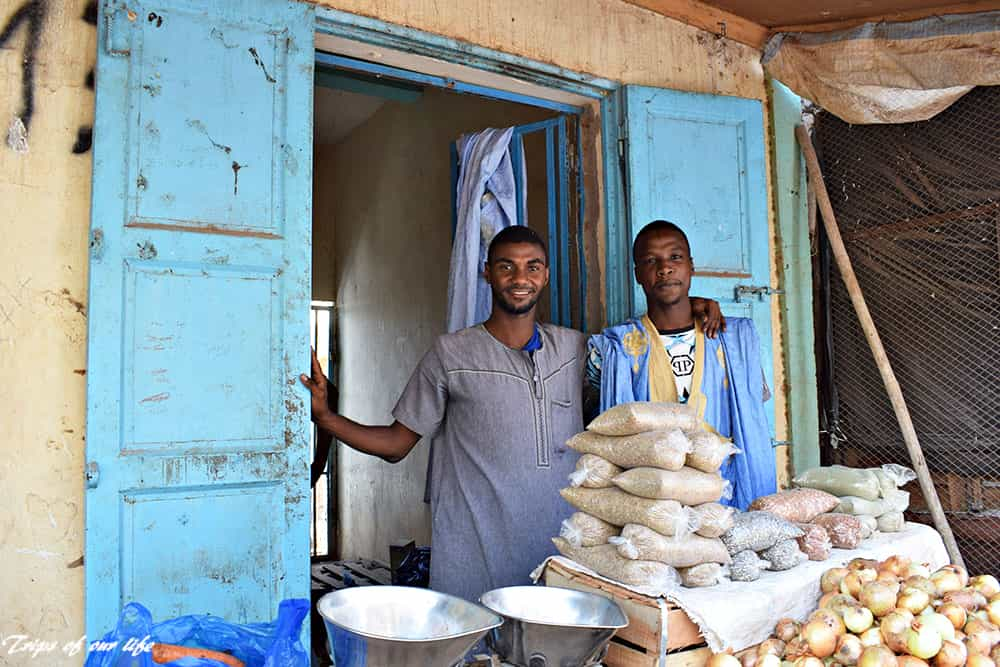
OUALATA & NEMA
This town, literally built in the middle of nowhere, was my favorite one of the whole country. Although I was thinking of visiting at the end of the trip, randomly came up as the next destination following the capital. The access was really hard: covering 1,200km from Nouakchott to Nema town by mini-van, and then, 100km more by jeep (shared taxi). It took me two and a half days, spending 2 nights at a random motel in Kiffa town and a local’s house in Nema, to finally reach my desired destination.
Both towns are located on the southeastern side of the country, right next to the border with Mali. Both are considered extremely dangerous, but in fact, they are not! Nema is the last town you can reach by conventional car. It is a small, dull, dirty town, and besides the very friendly locals, I did not find anything remarkable there. I spent most of my time hanging out with my wonderful hosts, a local family, and after visiting the central market, I left around 15.00hrs to the third ancient city of the country.
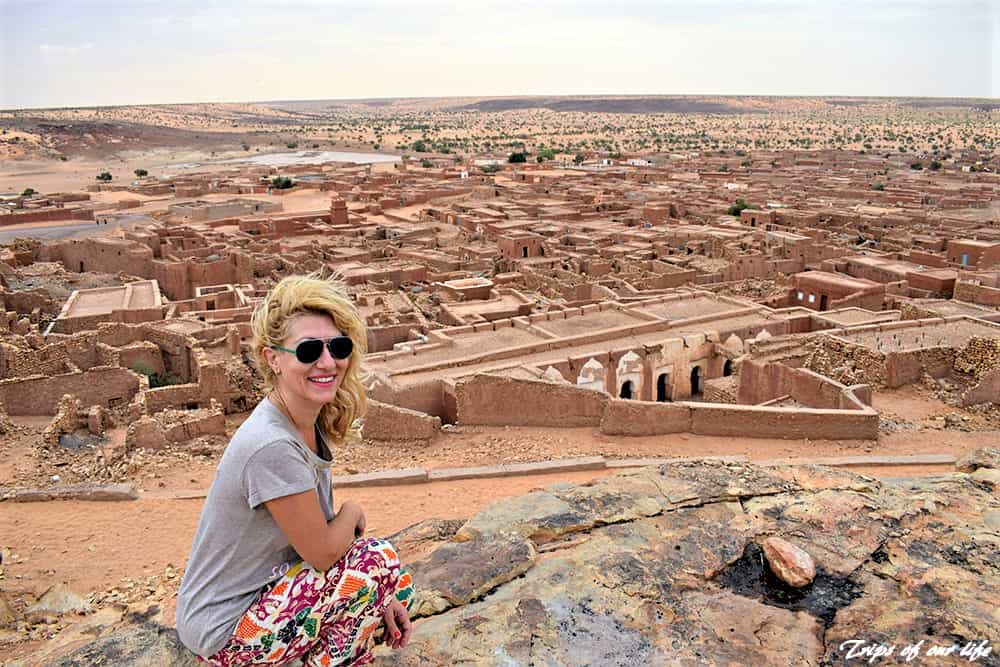
Oualata, on the other hand, is the gem of the desert, a beautiful colorful town, which, in my opinion, is the most beautiful of the country. It used to be a caravan station in the past, and now it is divided into 2 towns: the ancient one, famous for the wall murals of the old mud houses, which is built amphitheatrically on a hill and still inhabited, and the new one, with normal mud houses, built down on the plateau. I stayed 2 days/2 nights with a local family in the old town, and had the chance to experience once again their difficult everyday life, without running water, sewerage system, transportation. The locals were very friendly, although more conservative and closed than the rest of the Mauritanians I met. That makes sense, as the town is extremely isolated in this very remote part of the Sahara and tourists skip it, due to the long distance and the negative travel advice of several Embassies. (detailed post to follow soon)
Points of interest in Oualata:
- The whole ancient city and its half-ruined houses with the wall murals and the old wooden doors
- The inner courtyards of the old houses
- The old libraries with the ancient manuscripts – I visited two of them, a personal collection and the official library of the old town
- The view point on top of the hill, with the stunning views to the whole area
- The lake with the camels outside the new city
* I stayed with a local family at their house in the ancient town for 500UM, 2 nights/full board

TERJIT OASIS
Due to a long, sudden breakdown of the bus returning from Oualata, I had to spend one night in the capital and reach the most famous oasis of Mauritania, the next day. The journey from the capital to the town of Atar takes around 6hrs. However, in order to get to the oasis, I had to stop to an intersection, a few kilometers off Atar, in the middle of nowhere. I had already informed the driver since we departed from Nouakchott, so he left me at a police check point (military police to be precise), to wait for a random car to take me to the next check point. Unfortunately, there is no public transportation to the oasis, so the waiting time is unknown. While waiting, the policemen invited me inside the check point and offered me tea. The one and only car that finally passed by after too much time, it was a crowded truck. In order to avoid the people inside, I sat on the open back space, up to the next stop. The kind driver did not charge me anything and felt obligated to help me reach my destination safely.
The ride was amazing! There were no dunes in that area, just high cliffs into unusual formations. I was already traveling around the Adrar plateau, the huge dry area in central Mauritania, well known not only for its history and ancient towns, but also for its unique arid landscape, with mountains, canyons and endless dunes. At the next check point, the policemen called the owner of the camp where I would spend the night, and in a few minutes a friendly gentleman, Jemal, arrived by his car to pick me up. Although very basic, the camp is the most famous in the area, as it is located just outside the oasis, which you can visit on foot. The tents are simple, made of fabric, with a very thin mattress on the floor. Since there are no restaurants or shops around, Jemal offers meals as well (I booked dinner and breakfast). At first, I had no idea how much time I would need to spend in the area, but as there’s nothing else to do, one night was enough. (detailed post to follow soon)
Points of interest in Terjit:
- The most famous oasis in the country, lying along a small gorge, where you can take a walk up to the small pool / pond or just relax under the countless palm trees
- The nearby small village, for an authentic experience of the local life
- The view point at the camp, with the stunning views to the oasis, the village and the surrounding plateau
* Camp Chez Jemal prices: tent: 290UM / breakfast: 100UM / dinner: 250UM
* Entrance fee to the oasis: general fee: 200UM / Camp guests fee: 150UM


OUADANE
I arrived in Ouadane, the 4th oldest town in the country, by a shared taxi from Atar, and spent 2 nights in a hostel just outside the town. Ouadane is separated into 2 towns, the ancient and the new, both built on a hill. To enter the old town, you reach the entrance to the left of the main road, where you pay a small entrance fee, including a guide. The tour around the narrow alleys and the collapsed cobblestone houses of the ancient town (which is not inhabited) takes about one hour, up to the old mosque. Then, you can visit the new town by yourself. The old town is quite impressive, but apart from the ruins and the open view to the surrounding area, it does not offer any other attraction.
The new town is small and uninteresting. At first, I strolled around the streets and visited 2 schools. To my great disappointment, I met a lot of children who were not that friendly, although I offered them bonbons and balloons. The truth is that Ouadane was the only place I didn’t particularly like in the entire country, and unfortunately, I had to stay 2 nights, as I arrived late and it was already dark. Later on, I met a wonderful local, Sidi, the owner of the oldest house in the town and a great collection of several old manuscripts and stuff. I spent a lot of time admiring the cultural treasure he – unfortunately – cannot make use of it, and later, I was invited for the family lunch at his own house. (detailed post to follow soon)
Points of interest in Ouadane:
- The ancient town (entrance fee: 200UM guide inc.)
- The new town, just for a walk around
- The oldest house in town – a former museum, and Sidi’s private library with old manuscripts (tip 200UM)
* Auberge Zaida Vasque prices: Double: 1.000UM / Tent: 300UM / breakfast: 150UM / dinner: 250UM

CHINGUETTI
The most ancient town of Mauritania, an old caravan station, was the 2nd most picturesque and interesting place of my trip. I managed to arrive late at night by shared taxi, from a point in the middle of nowhere once again, just outside of Atar. That day was incredibly frustrating and one of the worst of my trip. The same morning I was supposed to leave Ouadane by a private jeep, crossing the dunes and arrive in Chinguetti around noon. Unfortunately, due to miscommunication, the jeep wasn’t booked, while I had already lost the public bus to Atar. So I was stuck in the only town I didn’t like, with no other way to leave. The police was once again the only solution. After spending the whole morning waiting for a random car at the main check point, they finally found a local who was driving to a village off Atar. I joined him up to the next check point, where I got stuck again, waiting for another car to take me to Chinguetti. The one and only nice memory of that day was the hospitality and kindness of the police officers, who felt sorry for me and offered me food and tea. Finally, a jeep passed by and managed to reach my destination, late in the afternoon.
Chinguetti is also divided into 2 towns, the ancient and the new one, both built in the desert, right close to the dunes. The original old town was located a few kilometers further east, but as the desert was spreading, the locals had to move, and the town is now buried under the sand. The following ancient town is now located right next to the dunes, more protected than the previous one, but with the risk of being covered by sand again in the future. The new town was built a little further back, without any particular interest. I initially stayed one night at a hostel in the new town, and early in the next morning I departed with a local, for a 3-day tour to a nomad settlement in the desert.
We walked 11km across endless golden dunes: me, the nomad and his camel, carrying my stuff and supplies for our stay in his relatives’ camp. That 2 nights-stay in a straw hut in the middle of the desert, was by far my favorite experience of this trip. We came back to Chinguetti the next morning, crossing the Sahara on foot once again and I spent the rest of the day visiting the old town with the cobblestone houses and the famous family libraries with the ancient manuscripts. (detailed post to follow soon)
Points of interest in Chinguetti:
- The ancient town, the old mosque, the Madrassas – Quran schools, and the 5 family libraries with the ancient manuscripts (entrance fee: 100UM)
- The surrounding golden dunes and the vast desert
* Auberge Zarga prices: basic room with shared toilet: 150 UM / Zarga garden: hut with shared toilet: 200 UM
breakfast: 50 UM / lunch: 100 UM / dinner: 200 UM
* Price for a 3-day tour in the desert: 60€

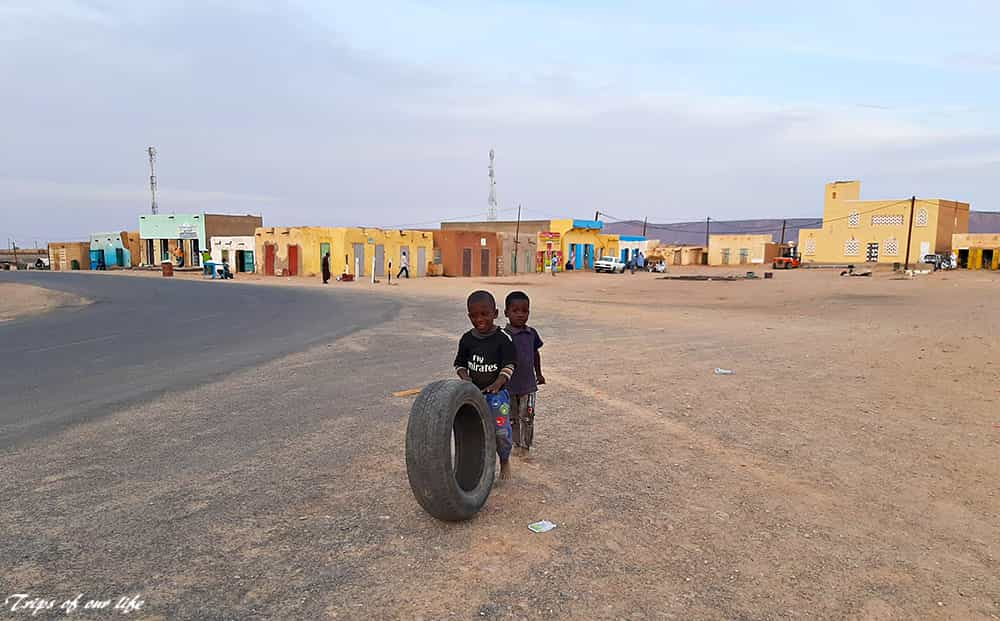
ATAR & CHOUM
Atar is a small town located in northern Mauritania, the main hub of the north part of the country. I only stopped twice there, while changing buses to Ouadane and Choum, as there isn’t any special tourist attraction to visit. Travelers usually stop in order to buy supplies for the tours to the surrounding area and the train ride, since there are several traditional restaurants, supermarkets and a large street market in the city center.
Choum is a small, uninteresting village, the second boarding station on the iron-ore train route, following the departure point in Zouerate. I spent several hours there waiting for the train, hanging out with the locals in a small restaurant.
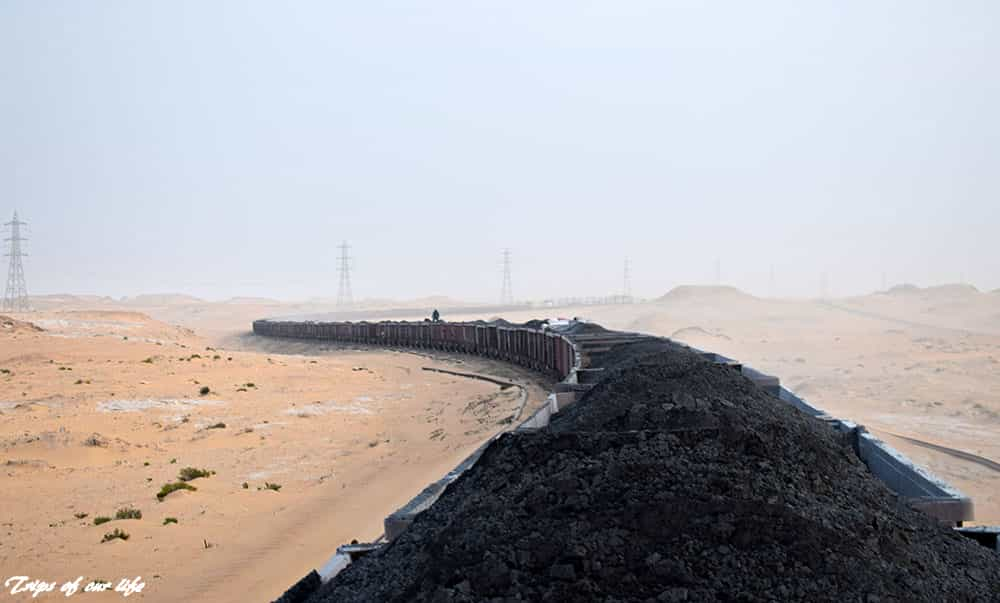
IRON ORE TRAIN – the longest cargo train in the world
Riding the iron-ore train is a special experience itself, while during the last years, it has become the highlight for the thrill-seekers visiting Mauritania. I boarded from the village of Choum and spent 12 hours on a wagon full of iron ore powder, to its final destination, the town of Nouadhibou.
More of this once in a lifetime experience here.
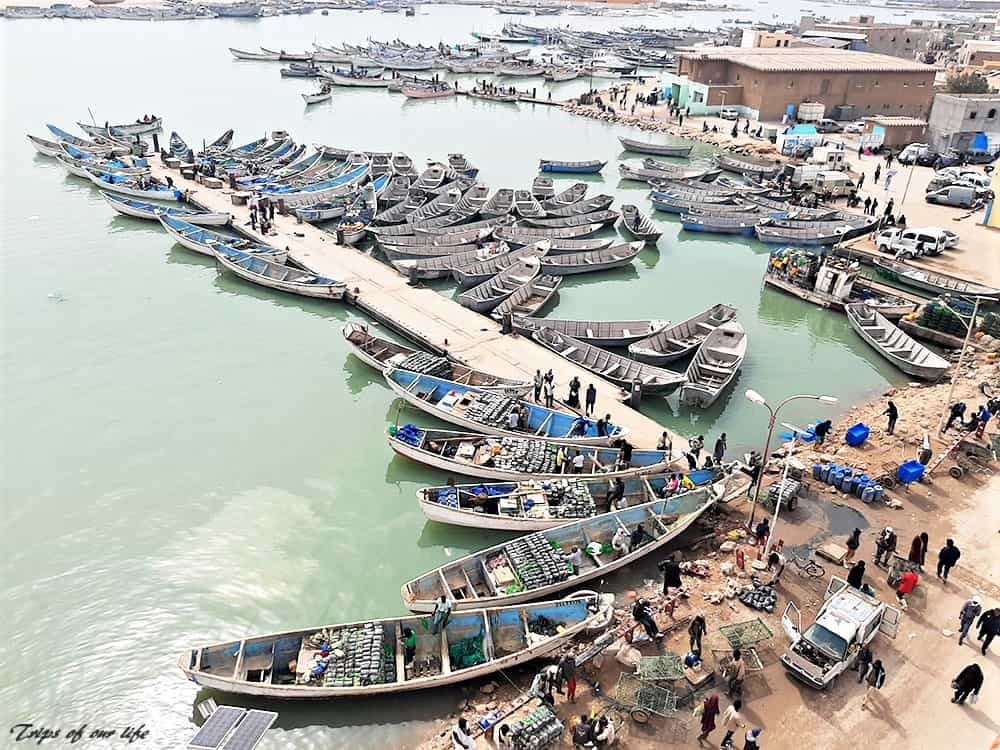
NOUADHIBOU
Nouadhibou is the second biggest city and the largest commercial center of Mauritania. The port is the final destination of the iron ore train from the mines of Zouerate and its fish market is the second largest in the country, after that one of Nouakchott. It lies on the eastern side of the peninsula divided between the Western Sahara and Mauritania, at the northwestern point of the country. The city itself is nothing special and looks alike the also uninteresting town of Dakhla in the Western Sahara. I arrived early in the morning, after the long 12-hours train ride, and headed directly to my room at a hotel in the city centre, in order to get a rest, bathe and clean my stuff from the dirt of the train. I spent my evening with a local friend, visiting the city and the beaches. The next morning I strolled around the bustling fish market and later on, I left by bus to the capital. (detailed post to follow soon)
Points of interest in Nouadhibou:
- Port de peches – the main port with the crowded fish market and the colorful pirogues
- The nearby beaches to swim or relax
* Hotel Al Jazera prices: Double room with European breakfast: 1.700 UM
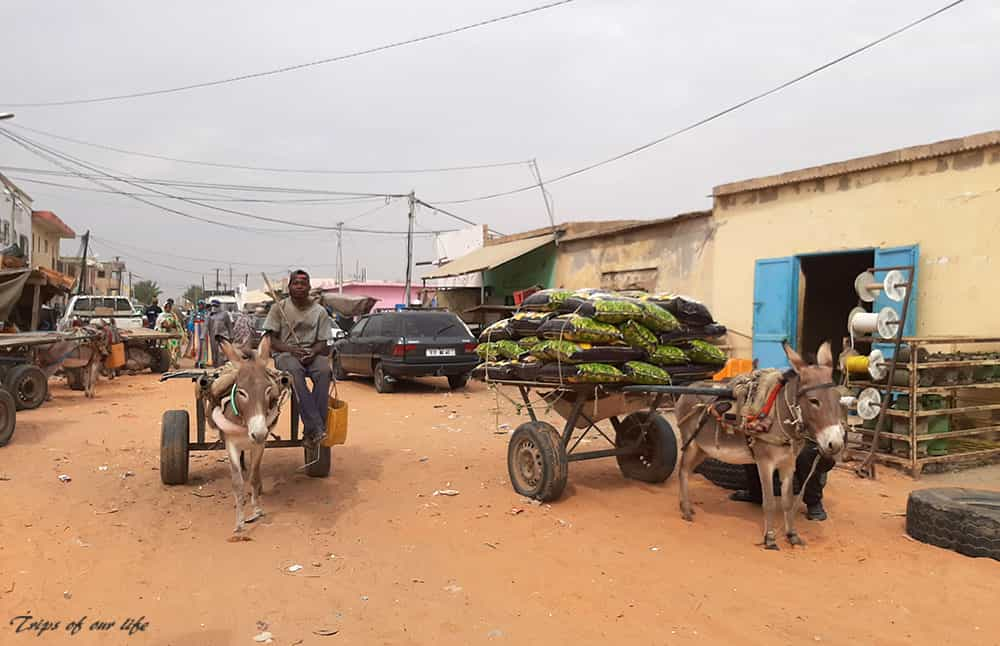
ROSSO
Rosso is a small town on the southern border with Senegal, built along the shores of the Senegal river. Those borders are notorious for being the worst in Mauritania and the most corrupted in the whole Africa. The town is a normal African one, uninteresting, crowded and full of trash. To my surprise, the crossing of the border and the entry to Senegal took me only a few minutes, without any problem at all. More details on a following blogpost.
Useful information
Local currency: ouguiyia UM / 1€ = 40,50UM (exchanging money in the black market is very common)
Local SIM card:
Moov Mauritel is considered to be the best company in the country.
Sim card rate: 150UM / 6GB weekend rate: 100UM / 2,5GB weekdays rate: 100UM / 2,5 hrs call rate: 100UM (internet connection is generally slow, while there is no signal in the desert areas, Nema, Oualata, etc)
Transportation around the country:
- Nouakchott – Nema: 1.300UM by minivan
- Nema – Oualata: 300UM by shared jeep / one way
- Nema – Nouakchott: 1.400UM by bus
- Nouakchott – Atar: 400UM by minivan
- Terjit – Atar: 150UM by shared taxi
- Atar – Ouadane: 400UM by shared taxi
- Atar – Chinguetti: 200UM by shared taxi
- Chinguetti – Atar: 200UM by shared taxi
- Atar – Choum: 400UM by minivan
- Nouadhibou train station – Nouadhibou city center: 400UM by taxi
- Nouadhibou – Nouakchott: 600UM by bus
- Nouakchott – Rosso: 250UM by bus
Safety:
I really feel sad while I am still reading the travel advice of various embassies regarding safety in Mauritania. Half of the country on those maps is colored in red, as a high risk area, due to terrorist groups, kidnapping of tourists, women harassment, etc. A big part of my trip took place in this forbidden area. The whole eastern side of the country, which I visited all alone by public transportation, is considered dangerous, even the train route along the Western Sahara border.
However, my own experience was completely different. I met only a few tourists in the north and the capital. The locals confirmed that terrorist groups no longer exist in the country and they have been living in peace for many years. There are a lot of military/police checkpoints everywhere around the country, especially on paved roads and the control is very strict. Although the officers check passports and visas only, and no longer ask for the fiche document as they used to, you should have several photocopies of your passport, in case they ask for it. I carried about 40 photocopies, which I didn’t need in the end.
In general, I met gentle locals, willing to help and not to take advantage of me, and I didn’t notice any suspicious behavior towards me, neither as a tourist, nor as a woman. Most of the time, they were just curious, trying to chat about my trip, and not to bother me. Keeping in mind that we should be careful wherever we travel, and even more as solo women, even in the safest corner of the planet a sudden, single incident can occur.
Nevertheless, I believe that Mauritania is a very safe country for all kinds of tourism and visitors.

